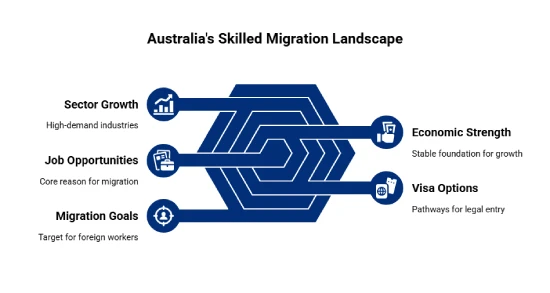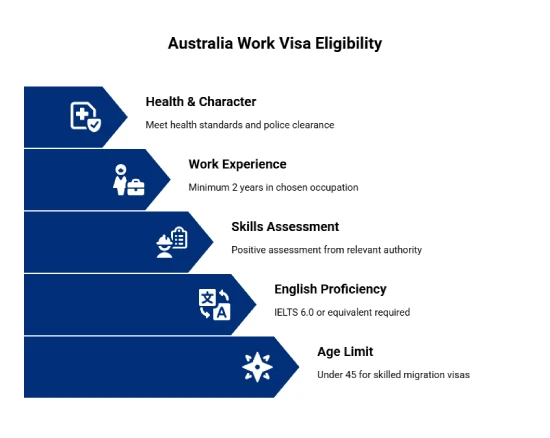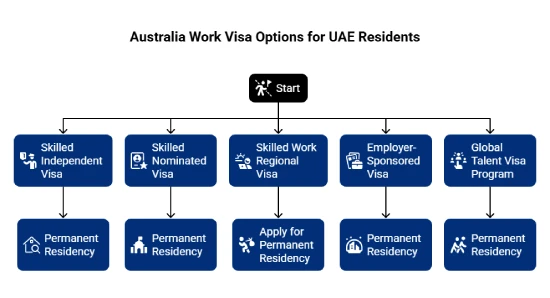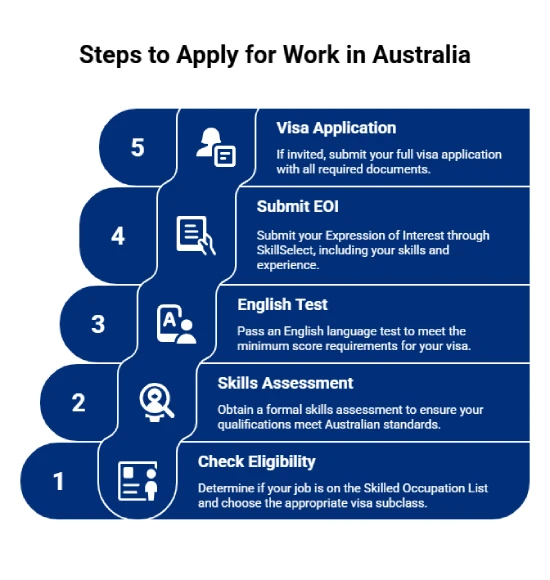Top In-Demand Occupations in Australia for 2025
Australia is a top overseas destination for skilled workers looking for job opportunities. With a strong economy and a focus on innovative ideas, the country provides various options for both jobs and permanent residency.
- The healthcare and IT fields grew by 9.2% in 2024, showing a strong demand for workers.
- Australia issued over 390,000 work permits in 2024, showing they are open to skilled migrants.
- Healthcare and engineering are still leading sectors for hiring.
- Blue Card and Skilled Worker visas provide clear options for applicants from the UAE.
- Australia aims to bring in 400,000 foreign workers each year to address skill shortages.

*Want guidance to apply for Australia work visa? Sign up with Y-Axis for comprehensive guidance with the process.
Why Choose Australia for Career Opportunities in 2025?
Australia has some great job opportunities due to its strong economy and high living standards. There is a high requirement for skilled workers in many areas. In addition, if you are in a high-demand field, there are good options for getting permanent residency.
The primary reason for working in Australia are given below.
- Economic Stability: Australia has a strong economy that supports job security and growth.
- High Quality of Life: Known for its great quality of life, Australia has top-notch healthcare, education, and infrastructure.
- Multicultural Society: People from different backgrounds are welcome in Australia’s diverse and inclusive environment.
- Pathways to Permanent Residency: There are several visa options available for those looking to gain Australia PR or permanent residency and citizenship.
- Work-Life Balance: In Australia, workplaces prioritize a good balance between work and personal life.
Top In-Demand Occupations in Australia (By Sector)
Australia is seeing a strong need for skilled workers in a few key areas. The big ones are Healthcare, IT, Construction, Education, and Trades, especially in Renewable Energy. Some jobs that are really in demand right now include Registered Nurses, IT pros like analysts and programmers, Civil Engineers, Early Childhood Teachers, and Construction Managers.
Healthcare and Medical Occupations
The healthcare industry in Australia is growing fast because more people are getting older and need more medical services.
|
Job Role |
Average Annual Salary (AUD) |
|
Neurosurgeon |
$600,000+ |
|
Anesthetist |
$350,000 – $550,000 |
|
Psychiatrist |
$250,000 – $450,000 |
|
General Practitioner (GP) |
$300,000 – $450,000 |
|
Internal Medicine Specialist |
$300,000 – $500,000 |
|
Surgeon |
$400,000+ |
|
Medical Oncologist |
$250,000 – $400,000 |
|
Radiologist |
$300,000 – $500,000 |
|
Obstetrician/Gynecologist |
$250,000 – $400,000 |
|
Emergency Medicine Specialist |
$250,000 – $400,000 |
Information Technology (IT) Jobs
Australia's IT sector is growing quickly, and there is a strong need for skilled workers in new technologies.
|
Job Role |
Average Annual Salary (AUD) |
|
Chief Information Officer |
$200,000 – $300,000 |
|
IT Security Architect |
$180,000 – $250,000 |
|
Software Engineer |
$100,000 – $150,000 |
|
Data Scientist |
$120,000 – $180,000 |
|
Cloud Solutions Architect |
$150,000 – $200,000 |
|
DevOps Engineer |
$110,000 – $160,000 |
|
AI/Machine Learning Engineer |
$130,000 – $180,000 |
|
IT Project Manager |
$135,000 – $155,000 |
|
Network Engineer |
$100,000 – $140,000 |
|
Business Intelligence Analyst |
$110,000 – $150,000 |
Engineering and Construction Roles
The engineering and construction sectors play a key role in building Australia's infrastructure and provide great job opportunities.
|
Job Role |
Average Annual Salary (AUD) |
|
Engineering Manager |
$150,000 – $200,000 |
|
Civil Engineer |
$95,000 – $120,000 |
|
Electrical Engineer |
$90,000 – $110,000 |
|
Mechanical Engineer |
$90,000 – $110,000 |
|
Structural Engineer |
$100,000 – $130,000 |
|
Construction Project Manager |
$175,000 – $200,000 |
|
Mining Engineer |
$130,000 – $200,000 |
|
Environmental Engineer |
$90,000 – $120,000 |
|
Geotechnical Engineer |
$100,000 – $130,000 |
|
Quantity Surveyor |
$90,000 – $110,000 |
Skilled Trades and Technical Roles
Skilled trades are really important for Australia’s economy, and there is a strong need for workers in different fields.
|
Job Role |
Average Annual Salary (AUD) |
|
Electrician |
$85,000 – $110,000 |
|
Plumber |
$80,000 – $100,000 |
|
Carpenter |
$75,000 – $95,000 |
|
Welder |
$70,000 – $90,000 |
|
HVAC Technician |
$70,000 – $90,000 |
|
Bricklayer |
$65,000 – $85,000 |
|
Painter |
$60,000 – $80,000 |
|
Mechanic |
$65,000 – $85,000 |
|
Roofer |
$60,000 – $80,000 |
|
Glazier |
$60,000 – $80,000 |
Finance, Banking & Accounting
There is a high requirement for finance professionals in Australia, and the pay is pretty good for different positions.
|
Job Role |
Average Annual Salary (AUD) |
|
Chief Financial Officer (CFO) |
$400,000 – $650,000 |
|
Investment Banker |
$150,000 – $400,000 |
|
Financial Controller |
$140,000 – $220,000 |
|
Actuary |
$130,000 – $200,000 |
|
Financial Analyst |
$90,000 – $110,000 |
|
Risk Manager |
$120,000 – $180,000 |
|
Tax Advisor |
$100,000 – $150,000 |
|
Auditor |
$90,000 – $120,000 |
|
Accountant |
$80,000 – $100,000 |
|
Compliance Officer |
$100,000 – $130,000 |
Education and Early Childhood
Australia's education sector is growing, especially in early childhood and special education.
|
Job Role |
Average Annual Salary (AUD) |
|
University Lecturer |
$100,000 – $140,000 |
|
Secondary School Teacher |
$80,000 – $100,000 |
|
Primary School Teacher |
$70,000 – $90,000 |
|
Special Education Teacher |
$80,000 – $100,000 |
|
Vocational Education Teacher |
$75,000 – $95,000 |
|
Early Childhood Educator |
$60,000 – $80,000 |
|
Education Administrator |
$90,000 – $120,000 |
|
Curriculum Developer |
$85,000 – $110,000 |
|
Instructional Designer |
$80,000 – $100,000 |
|
Education Consultant |
$90,000 – $120,000 |
Logistics, Transport and Driving
The logistics sector is growing because of online shopping and international trade.
|
Job Role |
Average Annual Salary (AUD) |
|
Supply Chain Manager |
$100,000 – $130,000 |
|
Logistics Coordinator |
$80,000 – $95,000 |
|
Warehouse Manager |
$85,000 – $100,000 |
|
Procurement Officer |
$90,000 – $110,000 |
|
Transport Planner |
$95,000 – $115,000 |
|
Freight Forwarder |
$80,000 – $100,000 |
|
Inventory Analyst |
$75,000 – $95,000 |
|
Distribution Manager |
$90,000 – $110,000 |
|
Fleet Manager |
$85,000 – $105,000 |
|
Operations Manager |
$100,000 – $130,000 |
Eligibility Criteria for Working in Australia
The eligibility requirement for Australia work visa is given below.
- Age: You need to be under 45 for skilled migration visas.
- English Skills: You should have at least a 6.0 on the IELTS or something similar.
- Skills Check: Get a positive assessment from the right authority.
- Work Experience: You need a minimum of 2 years in your chosen job.
- Health and Character: You have to meet health requirements and show a police clearance.

Which Australia Work Visa Options Are Available for UAE Residents?
There are multiple Australia work visa option are given below.
- Skilled Independent Visa (Subclass 189) - This is for skilled workers who do not have a job offer from an employer or family. It gives you permanent residency and full work rights.
- Skilled Nominated Visa (Subclass 190) - You need to be nominated by an Australian state or territory for this visa. It also leads to permanent residency, but you have to live in the state that nominated you.
- Skilled Work Regional Visa (Subclass 491) - This is a temporary visa for skilled workers in regional areas. After three years, you can apply for permanent residency.
- Employer-Sponsored Visa (Subclass 482) - This is a temporary visa that lets employers fill job gaps. It can also lead to permanent residency down the line.
- Global Talent Visa Program - This is for people with outstanding skills in certain fields. It offers a smoother path to permanent residency.

Application Process for Working in Australia from the UAE
The procedure to apply for work in Australia is given below.
Step 1: Check if your job is on Australia’s Skilled Occupation List and pick the right visa subclass (like 189, 190, 491, or 482). Look at the points system, job demand, and see if you need a state nomination or a job offer.
Step 2: Get a formal skills assessment from the right authority for your job. This shows your qualifications and experience meet Australian standards.
Step 3: Take an English language test like IELTS, PTE Academic, or TOEFL iBT. Make sure your scores hit the minimum needed for your visa category.
Step 4: Log into SkillSelect and submit your Expression of Interest with your skills and experience. If you are applying for a state-nominated visa, you can also apply directly to the state.
Step 5: If you get invited, submit your full visa application online. Include your skills assessment, English test scores, ID documents, and work history. Then just wait for the results and get ready to move.

How Long Does It Take to Move to Australia for Work?
Detailed information about the processing times of different Australian work visas are given below.
|
Visa Subclass |
Estimated Processing Time |
|
Subclass 189 |
Approximately 6–9 months |
|
Subclass 190 |
Approximately 8–12 months |
|
Subclass 491 |
Approximately 12–14 months |
|
Subclass 482 |
Approximately 3–6 months |
How Much Does It Cost to Apply for an Australian Skilled Visa?
The breakdown of costs for Australian skilled visas is given below,
|
Fee Type |
Estimated Cost |
|
Skills Assessment Fee |
AUD 500–1,000 (varies by occupation) |
|
English Test (IELTS/PTE) |
Approximately AED 1,100 |
|
Visa Application Fee |
Starting from AUD 4,640 |
|
Medical & Police Clearance |
Approximately AED 800–1,000 |
Can My Family Join Me in Australia?
Yes, your family can be sponsored to join you In Australia. You can include your spouse and children in the visa application. Your spouse can work, and your children can avail education can go to school. In addition, eligible family members can apply for Australia PR.
How Can Y-Axis Help You?
Y-Axis is ready to help you with your immigration process to Australia. We offer:
- Advice on visa options and what you need to qualify.
- Assistance with paperwork and applications.
- Job search help and tips for your resume.
- Support for your journey, both before and after you get here.
Feel confident starting your career in Australia with Y-Axis by your side.
Looking for Inspiration
Explore what Global Citizens have to say about Y-Axis in shaping their future
Frequently Asked Questions
